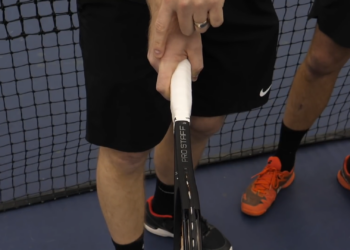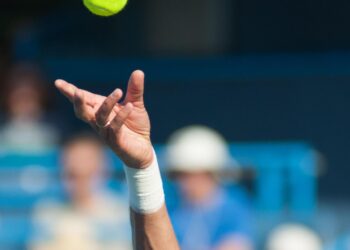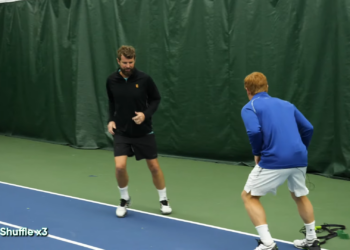Growing up, a teaching pro used to tell me, “You’re only as good as your second serve.”
He would always say, “I only need to see one ball, and that’s the second serve if I want to see how good somebody is.”
The first serve might be the glamour shot, but the second serve is the real MVP.
It’s the shot that shows up when things go wrong. When the scoreboard tightens. When your confidence wavers.
It’s your second serve that either keeps you in the fight or hands your opponent the point gift-wrapped with a bow.
This guide isn’t about playing it safe, it’s about transforming your second serve from a liability into a weapon.
We’re going to walk through how to build spin, trust your motion under pressure, disguise your intent, and most importantly, swing with confidence, every single time.
Let’s fix your second serve and start winning more matches because of it.
What Actually Makes a Second Serve Great?
Power Without Risk = Spin
If there’s one thing I wish every player would tattoo on their tennis brain, it’s this: your racquet speed on the second serve should match your first.
Nearly every club player I’ve coached slows down on their second serve because they’re scared to miss. And what do they get for it? A timid “please go in” toss-up that gets pounced on or floats wide.
Power comes from swinging confidently. And when you add spin, you get the magic combo: pace + safety. That’s how you hit second serves you can trust and that opponents can’t attack.
Spin is your built-in insurance policy.
Topspin adds net clearance and drops the ball safely into the box, even when you swing full.
Slice creates movement that keeps your opponent guessing and pulls them off the court.
Without spin, you’re relying on perfect aim. With spin, you’re building margin and momentum.
Reliability Under Pressure
Now let’s talk about pressure, because that’s where most second serves fall apart.
You don’t need a bomb of a second serve to win.
You need a serve that you can repeat. That shows up when it’s 30-40 or tiebreak time. Your opponent can’t attack what doesn’t miss.
We teach a concept called the “Margin Map.” Most players aim at the service box in general. But that’s like shooting a basketball at the backboard instead of the hoop.
Instead, we train players to aim for high-margin zones:
- Above the net with arc (not just over the tape)
- A few feet inside the service box lines
- Away from the center line to avoid letting returns come right back up the middle
The smaller your target, the more precise your serve becomes under pressure.
Think of it like this: when the heat is on, your serve shrinks to your level of preparation. Margin builds reliability. And reliability wins matches.
Targeting with Intent
Here’s a second serve mistake I see constantly: players just try to get the ball in.
They pick a generic spot, or worse, they don’t aim at all.
Let me be clear: your job on the second serve is not survival, it’s setup.
Ask yourself: what’s the returner’s weaker wing? If you don’t know, assume it’s the backhand. (Because 90% of the time, it is.)
Specific targeting takes the pressure off you and puts it on your opponent.
Tour pros don’t gamble with their second serves. They have pre-set patterns: kick to the backhand on the ad side, slice wide on the deuce, body serve when the opponent crowds the baseline.
These are repeatable, low-risk targets that yield high returns.
And yes, you can run these patterns too, no matter your level. With some spin, a clear target, and a confident swing, you’ll stop thinking “I hope this goes in” and start thinking “I dare you to attack this.”
Why Most Second Serves Fail
The Dart Player Mentality
Let’s call it what it is: most second serves fail because players are scared.
You’ve seen it. You’ve probably done it. That moment after missing the first serve when your body tightens, your mind screams “just get it in,” and your arm follows with a tentative poke, like you’re tossing a dart instead of swinging a racquet.
Instead of accelerating through the ball, you decelerate.
You shorten your motion. You swing like you’re afraid of your own power. And what happens? You either double-fault or float in a sitter that your opponent devours. Neither is a win.
Decelerating is more dangerous than swinging full.
That’s because a slower swing reduces spin, eliminates margin, and ruins rhythm. The serve doesn’t “just go in”, it dies on you.
If you want a second serve that holds up under pressure, you have to commit.
Acceleration is not optional, it’s the solution.
Toss Inconsistency
Here’s the next silent killer of second serves: the toss.
If your toss is too low, too far out front, or too far behind, you’ve already lost before the racquet moves.
You can’t generate consistent spin if the ball’s not in the right place. And spin is what gives your second serve its safety net.
What most rec players don’t realize is that your toss needs to be nearly identical for all serve types, especially if you want disguise.
Kick, slice, flat, they all start from the same motion and release point. If you have to toss differently for every variation, your opponent will see it coming a mile away.
We coach a single principle: same toss, different wrist.
You can change the serve type using racquet face angle or spin path, not your toss. That way, you stay balanced, consistent, and unpredictable.
Mental Blocks and Decision Fatigue
This is one of the most common blocks I see, even in experienced players. It’s called decision fatigue, and it kills second serve execution.
The more choices you give yourself (kick? slice? body? wide?), the more your confidence melts, and the more likely you are to overthink, tighten up, and miss.
That’s why we simplify the process. Here’s our golden rule: Have your serve plan BEFORE you toss the ball. Not during. Not mid-motion. Not after you panic.
Start with one trusted second serve, like a kick serve to the backhand, and build from there.
Add in a slice once you trust the motion. Then introduce body placement. But always keep your base serve locked in as your default.
Kick vs. Slice: What’s Best for Your Second Serve?
Both the kick and slice serve are second serve gold.
They give you the margin for error, disguise, and variety that every player needs to stay in control.
But they’re not interchangeable. Each has its strengths, limitations, and ideal use cases. Let’s break it down.
Kick Serve
If you’re looking for a second serve that clears the net by a mile and still drops in, this is your guy.
The kick serve uses heavy topspin to arc the ball high over the net and bounce aggressively up and away from your opponent.
That high, twisting bounce makes it especially tough for players with weak backhands or limited reach.
Pros:
- Clears the net with room to spare, great for high-pressure points
- Kicks up high and pushes returners back, especially on the ad side
- Nearly impossible to attack when placed to the backhand
- Buys you more time to recover or approach the net in doubles
Cons:
- Requires solid mechanics and body rotation to generate vertical spin
- Can be tough on the lower back if form breaks down
- Easier to read than other serves if your toss or motion is too obvious
Slice Serve
If the kick serve is your high-bouncer, the slice serve is your sidewinder.
It curves away from your opponent or into their body, depending on your placement and it does it with less strain on your body.
Pros:
- Natural movement that pulls opponents wide or jams them inside
- Easier on the back and shoulders than the kick
- Fantastic for body serves, especially into the returner’s backhand hip
- Ideal for carving sharp angles on the deuce side
Which One Is Right for You?
You don’t need to master both today, but you do need to start building comfort with each.
We recommend the following test:
Drill: Slice vs. Kick – Same Toss, Same Rhythm
- Hit 10 serves using a slice motion.
- Hit 10 serves using a kick motion.
- Use the same toss for both. Don’t adjust your mechanics mid-motion.
- Focus on height, spin, and consistency, not power.
- Track where each serve lands and how repeatable it feels.
This drill does two things:
- It tells you which serve feels more natural under pressure.
- It trains your toss and rhythm to stay consistent, so you can disguise your second serve, no matter what spin you’re using.
Start with the one that feels most comfortable. Add the other over time.
Because when you’ve got both the kick and slice serve in your toolbox, your opponents won’t just guess wrong, they’ll dread returning your second serve.
Build a Consistent Second Serve Routine
The biggest difference between your practice court serve and your match-day second serve? Ritual.
When the scoreboard tightens, your brain starts to race. That’s when bad habits sneak in, rushed tosses, hesitant swings, and sloppy footwork.
The solution? A rock-solid, repeatable second serve routine that brings your focus back to execution.
The Pre-Serve Ritual
This is your serve’s “reset button.” It signals to your mind and body that it’s time to swing freely.
Without a ritual, you’re guessing. With one, you’re grounded.
Here’s the PlayYourCourt version of a battle-tested ritual:
- Breathe. One deep breath in through the nose, slow exhale through the mouth. This clears mental noise and centers your focus.
- Bounce. Tap the ball two to three times, same number every time. Don’t rush it. Let your rhythm settle.
- Visualize. Before your toss, take one second to picture the serve’s shape: spin, arc, landing zone. Feel the shot before you hit it.
That’s it. Keep it simple. This 5-7 second process creates relaxation, rhythm, and repeatability, three things your nervous system craves when the match is on the line.
Players at every level—tour pros, juniors, club warriors—use rituals. Not because they’re superstitious, but because they work.
Visualization = Execution
Ever wonder why some players seem to hit the same great second serve again and again? It’s not magic, it’s mental rehearsal.
Right before you toss, you should be seeing the serve in your mind’s eye. Visualize:
- The arc of the ball: high over the net, with shape and safety.
- The landing zone: not just “in the box,” but a specific 2×2 foot target.
- The spin path: how the strings brush the ball—up and over for kick, across for slice.
This mental rehearsal preps your body to execute. If you’re thinking “don’t miss” or “just get it in,” you’re feeding anxiety. But if you focus on trajectory and shape, you give your brain a clear blueprint for action.
Remember: the brain can’t focus on a negative (like “don’t double fault”), so give it something positive to chase.
Decision, Then Commitment
Indecision is the root of most second serve errors.
One of the biggest worries I hear from players is, “I don’t know what serve to hit when I’m nervous.” That uncertainty leads to hesitation. And hesitation leads to the classic double fault.
You’ve probably experienced this: you toss the ball up, mid-swing you change your mind… and the ball flies into the net.
Why? Because your body follows your mind, and your mind didn’t commit.
The fix is simple: make your serve decision before you bounce the ball. And once you do, don’t change it.
Pick the serve type (kick, slice), the target (backhand shoulder), and the intent (aggressive spin or safe arc). Then go. No second-guessing.
One of our core mantras at PlayYourCourt is this:
“Doubt = double fault.”
When you commit, you swing freely. When you hesitate, you tense up.
Confidence is about making a decision and owning it.
Mastering a consistent second serve routine helps you think better under pressure.
And that’s the edge that separates the players who fold at 30-all from the ones who break serve and fist-pump to the bench.
Overcoming Mental Blocks on the Second Serve
A second serve is mental warfare. If your brain tightens up, your swing follows.
Here’s how to tackle the most common fears I see every day on the court.
Worry #1: “I double fault too much.”
The problem? You’re trying not to miss instead of trying to swing well. That mindset leads to hesitation, and hesitation leads to, you guessed it, more double faults.
Fix: Shift your goal from “just get it in” to “commit to the swing.” Trust the process. Double faults go down when you stop fearing them.
Worry #2: “I get tight when it matters.”
Tension shows up when your routine disappears. Without reps under pressure, your body panics.
Fix: Use a pre-serve ritual. Train with pressure drills like one-serve match play. Prepare your serve for battle, not just practice.
Worry #3: “I swing too slow because I’m scared.”
Slowing down kills your serve. The ball won’t drop without spin.
Fix: Don’t reduce speed, increase spin. Acceleration plus topspin gives you the margin and confidence to swing freely, even when you’re nervous.
Second serve confidence is built, not born. Train your mind like you train your motion and you’ll swing with purpose instead of panic.
Your Serve Blueprint: From Liability to Weapon
It’s time to put it all together into a system you can rely on under pressure.
Here’s your second serve success checklist:
- Same racquet speed as your first serve? ✅
You’re swinging through with confidence, not poking it in. - Spin on command (kick or slice)? ✅
You’re using topspin or slice to control the ball, not fear. - Repeatable toss and ritual? ✅
You’ve got a consistent rhythm that calms your nerves and locks in execution. - Confident second serve targets? ✅
You’re not just aiming at the box, you’re aiming with purpose, especially to the backhand.
Action Step:
Test your second serve every week in match play.
Track your percentage in, especially under pressure, and adjust based on real results. Serve stats don’t lie, and improvement becomes easy when you measure what matters.
Bonus: Advanced Tips for Intermediate and Tournament Players
If you’re already landing second serves with confidence, these upgrades will take you to the next level.
- Master disguise: Use the same toss and motion for slice, kick, and flat. Make your second serve unpredictable, even to advanced opponents.
- Vary your positioning: Shift your stance on the baseline, wide, middle, even closer to the center mark, to change angles and keep returners guessing.
- Record and review: Use slow-motion video to study your toss, contact point, and swing path. You’ll catch flaws you’d never feel in real time.
- Split your stats: Track your second serve success separately on the ad and deuce sides. You might be surprised where you need the most work.
When you start treating your second serve like a weapon, not just a backup plan, you stop surviving points… and start winning them.
Stop Playing Darts. Start Playing Tennis.
If your second serve has ever felt like a tightrope walk, where one slip means a double fault or a rreturn winner, you now know it doesn’t have to be that way.
Your second serve doesn’t just have to “go in.”
When trained right, it becomes a launchpad for winning the point. It creates pressure, earns short returns, and gives you the control to start rallies on your terms.
And most importantly, it replaces fear with confidence.
PlayYourCourt specializes in helping players like you, dedicated adults who are hungry to improve, transform their games faster.
Our membership gives you everything you need to make that leap:
- Guided serve challenges that teach you spin and consistency
- Video coaching that breaks down your mechanics step-by-step
- Personalized improvement plans based on your match performance
- Drills that simulate real match pressure, because baskets aren’t enough
We built this platform to help you stop feeling stuck and start seeing results.
Not with cookie-cutter YouTube tips or overpriced private lessons, but with a proven system that meets you where you are and gets you where you want to go.
Need a coach to fix your second serve fast? Explore our membership and get started with a 7-day free trial.
Don’t just get your second serve in. Make it dangerous. Let’s get to work.



